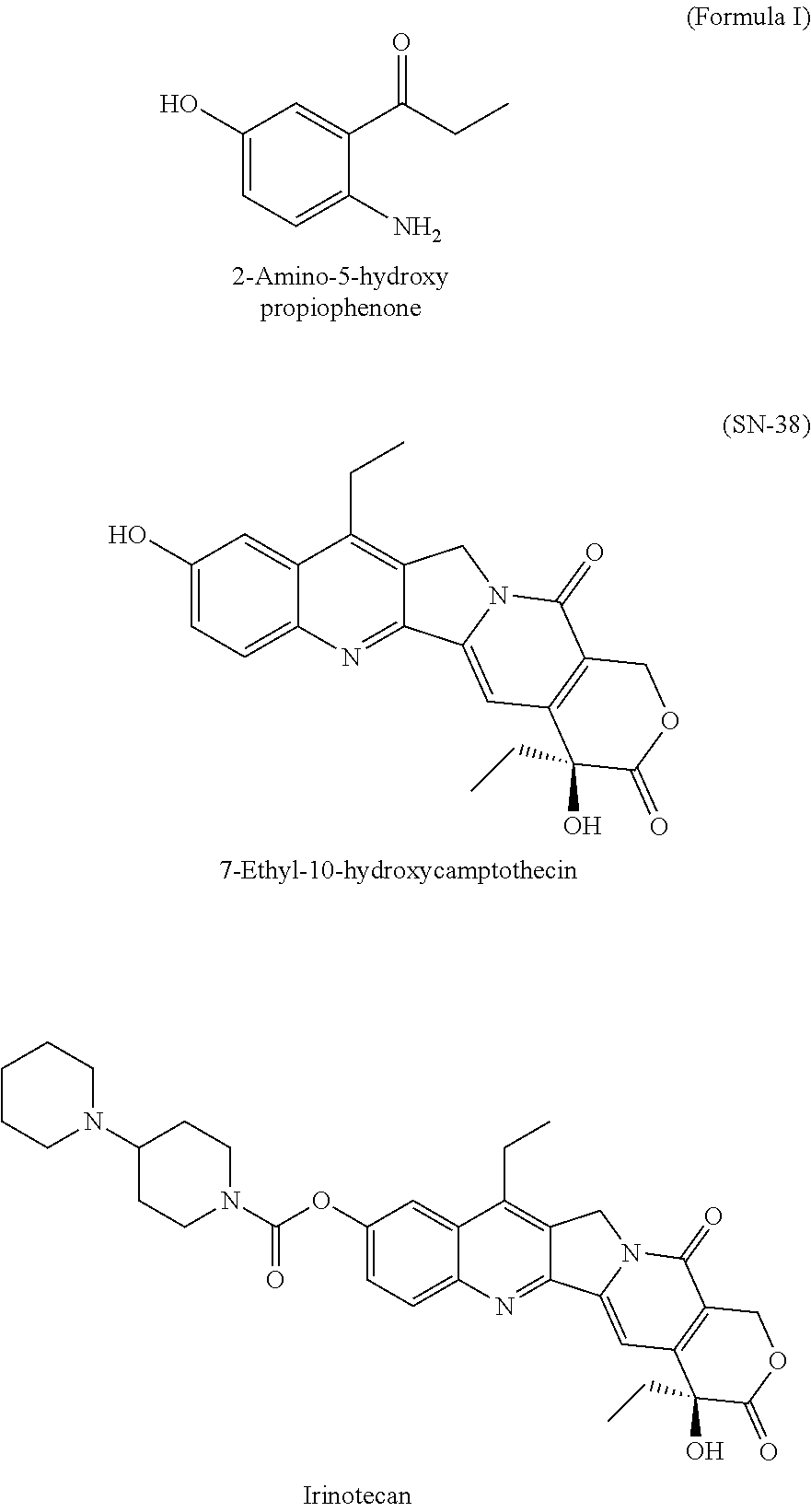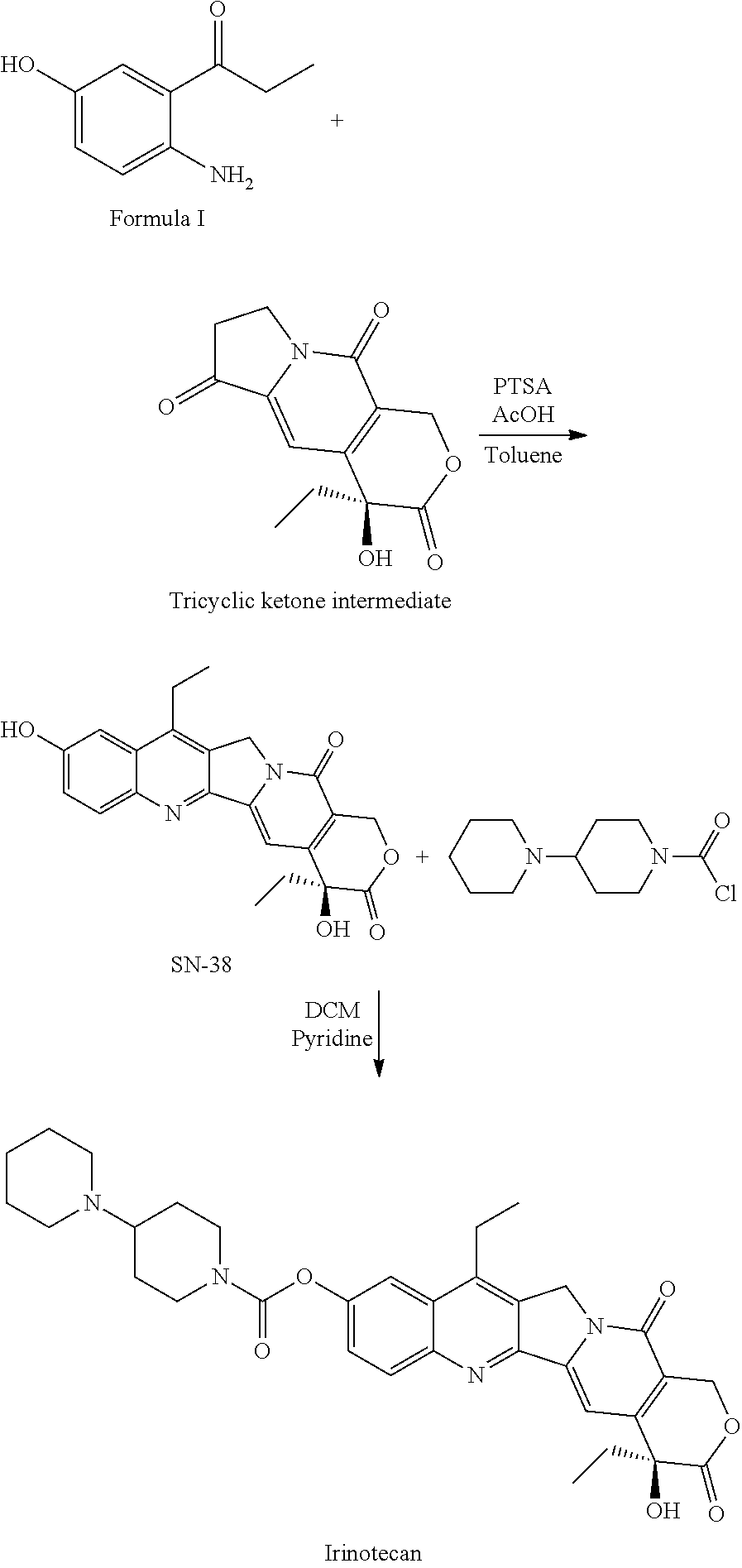Process for preparation of 2-Amino-5-hydroxy propiophenone
a technology of propiophenone and propiophenone, which is applied in the preparation of nitro compounds, chemistry apparatus and processes, organic chemistry, etc., can solve the problems of low reaction selectivity, hazardous reactions, and less yields with low purity
- Summary
- Abstract
- Description
- Claims
- Application Information
AI Technical Summary
Benefits of technology
Problems solved by technology
Method used
Image
Examples
example 1
Preparation of Compound of Formula IIIa (PG: 2,2,2-trichloroethyl Chloroformate)
[0190]To a 2 lit round bottom flask fitted with a mechanical stirrer, thermometer was charged water (700 ml) and 3-hydroxy propiophenone (140 g) at 25° C. to 30° C. Reaction mass was cooled to 0° C. to 10° C. and was added NaOH solution (39.1 g of NaOH dissolved in 140 ml of water). Stirred the reaction mass for 10 min at same temperature and added 2,2,2-trichloroethyl chloroformate (237.3 g) to the reaction mass while maintaining the temperature below 10° C. Reaction mass was stirred for 2 hr at 0° C. to 10° C. After completion of the reaction, filtered the solid and was washed the cake with hexane (300 ml) and dried the wet material under vacuum to get 224 g of Formula III. 1H NMR (DMSO): δ=1.09 (t, 3H), 3.07 (q, 2H), 5.08 (s, 2H) 7.57-7.96 (m, 4H); Purity by HPLC: 99.5%.
example 2
Preparation of compound of Formula IVa (PG: 2,2,2-trichloroethyl Chloroformate)
[0191]To a 1 lit round bottom flask fitted with a mechanical stirrer, thermometer was charged compound of Formula IIIa from Example-1 (50 g) and methylene chloride (500 ml) at 25° C. to 30° C. To the reaction mass was added anhydrous sodium sulphate (25 g) at same temperature. Reaction mass was cooled to 5° C. to 10° C. and was added sulphuric acid (125 ml). Reaction mass was cool to −1° C. and was added potassium nitrate (38.7 g) portion-wise at same temperature. Reaction mass was stirred for 60 min at 5-10° C. After completion of the reaction, poured the reaction mass into pre cooled water (1000 ml). Separated the organic layer and aqueous layer was extracted methylene chloride (400 ml). Then the combined organic layer was washed with 2M NaOH solution (500 ml) and 10% sodium chloride solution (500 ml). Combined organic layer was completely distilled under vacuum to afford 47.3 g of Formula IV. 1H NMR (D...
example 3
Preparation of Compound of Formula V
[0192]To a 1 lit round bottom flask fitted with a mechanical stirrer, thermometer was charged compound of Formula IVa (46 g) from Example-2, potassium carbonate (25 g) and methanol (500 ml) at 25° C. to 30° C. and stirred the reaction mass for 60 min at same temperature. After completion of the reaction, filter the salts and to the filtrate charged water (500 ml). Aqueous layer was washed with methylene chloride (250 ml). pH of the mass was adjusted to 3.5 using hydrochloric acid solution. Then the reaction mass was extracted with methylene chloride (1×500 ml and 1×250 ml). Combined organic layer was washed with water (250 ml). Organic layer was distilled completely under vacuum and stripped out the residue with hexane (100 ml). Charged toluene (50 ml) to the crude material and stirred for 30 min at 25° to 30° C. Filtered the solid to afford 20 g of Formula V. 1H NMR (DMSO): 5=1.10 (t, 3H), 2.77 (q, 2H), 6.81 (d, J=2.4 Hz, 1H), 6.99 (dd, 1H), 8.10...
PUM
| Property | Measurement | Unit |
|---|---|---|
| temperature | aaaaa | aaaaa |
| temperature | aaaaa | aaaaa |
| temperature | aaaaa | aaaaa |
Abstract
Description
Claims
Application Information
 Login to View More
Login to View More - R&D
- Intellectual Property
- Life Sciences
- Materials
- Tech Scout
- Unparalleled Data Quality
- Higher Quality Content
- 60% Fewer Hallucinations
Browse by: Latest US Patents, China's latest patents, Technical Efficacy Thesaurus, Application Domain, Technology Topic, Popular Technical Reports.
© 2025 PatSnap. All rights reserved.Legal|Privacy policy|Modern Slavery Act Transparency Statement|Sitemap|About US| Contact US: help@patsnap.com



